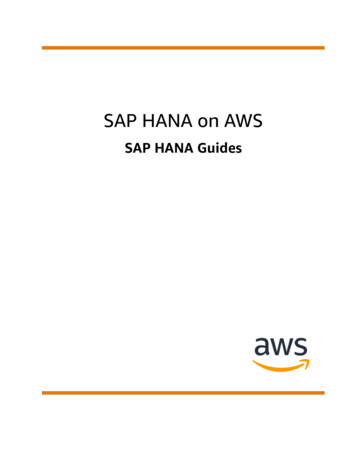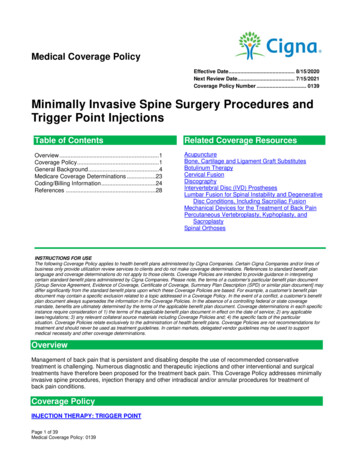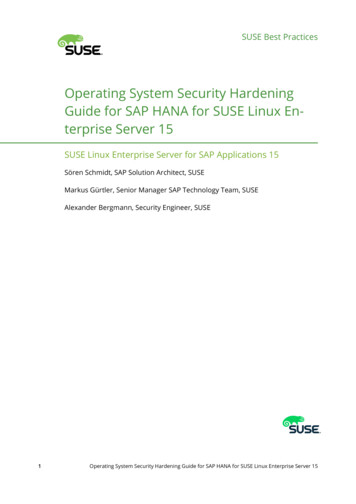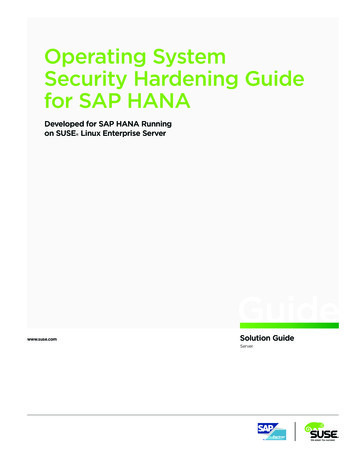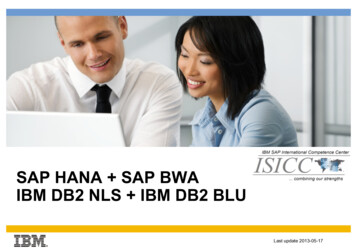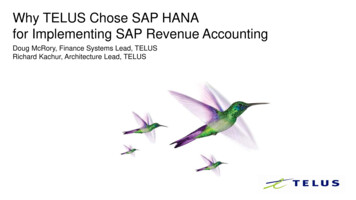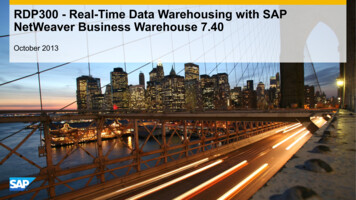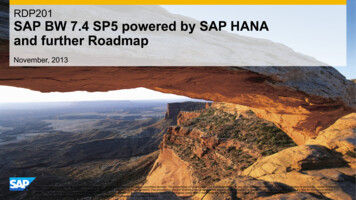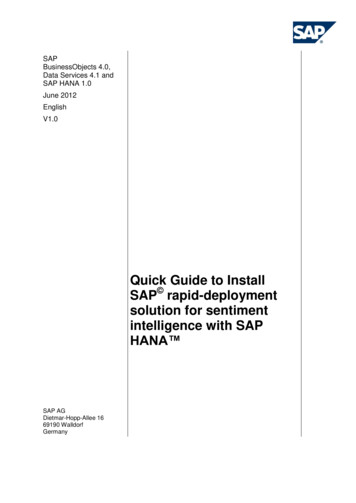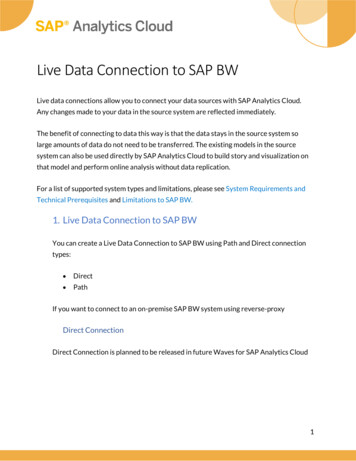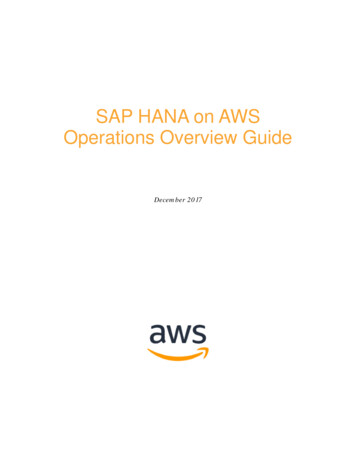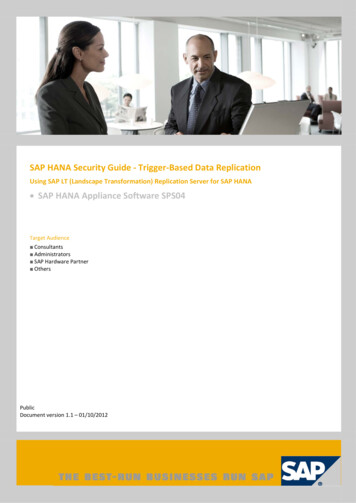
Transcription
SAP HANA Security Guide - Trigger-Based Data ReplicationUsing SAP LT (Landscape Transformation) Replication Server for SAP HANA SAP HANA Appliance Software SPS04Target Audience Consultants Administrators SAP Hardware Partner OthersPublicDocument version 1.1 – 01/10/2012
Copyright Copyright 2012 SAP AG. All rights reserved.No part of this publication may be reproduced or transmitted in any form or for any purposewithout the express permission of SAP AG. The information contained herein may bechanged without prior notice.Some software products marketed by SAP AG and its distributors contain proprietarysoftware components of other software vendors.Microsoft, Windows, Excel, Outlook, and PowerPoint are registered trademarks of MicrosoftCorporation.IBM, DB2, DB2 Universal Database, System i, System i5, System p, System p5, System x,System z, System z10, System z9, z10, z9, iSeries, pSeries, xSeries, zSeries, eServer, z/VM,z/OS, i5/OS, S/390, OS/390, OS/400, AS/400, S/390 Parallel Enterprise Server, PowerVM,Power Architecture, POWER6 , POWER6, POWER5 , POWER5, POWER, OpenPower,PowerPC, BatchPipes, BladeCenter, System Storage, GPFS, HACMP, RETAIN, DB2Connect, RACF, Redbooks, OS/2, Parallel Sysplex, MVS/ESA, AIX, Intelligent Miner,WebSphere, Netfinity, Tivoli and Informix are trademarks or registered trademarks of IBMCorporation.Linux is the registered trademark of Linus Torvalds in the U.S. and other countries.Adobe, the Adobe logo, Acrobat, PostScript, and Reader are either trademarks or registeredtrademarks of Adobe Systems Incorporated in the United States and/or other countries.Oracle is a registered trademark of Oracle Corporation.UNIX, X/Open, OSF/1, and Motif are registered trademarks of the Open Group.Citrix, ICA, Program Neighborhood, MetaFrame, WinFrame, VideoFrame, and MultiWin aretrademarks or registered trademarks of Citrix Systems, Inc.HTML, XML, XHTML and W3C are trademarks or registered trademarks of W3C , WorldWide Web Consortium, Massachusetts Institute of Technology.Java is a registered trademark of Sun Microsystems, Inc.JavaScript is a registered trademark of Sun Microsystems, Inc., used under license fortechnology invented and implemented by Netscape.SAP, R/3, SAP NetWeaver, Duet, PartnerEdge, ByDesign, SAP Business ByDesign, andother SAP products and services mentioned herein as well as their respective logos aretrademarks or registered trademarks of SAP AG in Germany and other countries.Business Objects and the Business Objects logo, BusinessObjects, Crystal Reports, CrystalDecisions, Web Intelligence, Xcelsius, and other Business Objects products and servicesmentioned herein as well as their respective logos are trademarks or registered trademarks ofBusiness Objects S.A. in the United States and in other countries. Business Objects is anSAP company.All other product and service names mentioned are the trademarks of their respectivecompanies. Data contained in this document serves informational purposes only. Nationalproduct specifications may vary.These materials are subject to change without notice. These materials are provided by SAPAG and its affiliated companies ("SAP Group") for informational purposes only, withoutrepresentation or warranty of any kind, and SAP Group shall not be liable for errors oromissions with respect to the materials. The only warranties for SAP Group products and
SAP HANA Security Guide – Trigger-Based Replication (SLT)services are those that are set forth in the express warranty statements accompanying suchproducts and services, if any. Nothing herein should be construed as constituting anadditional warranty.Icons in Body taxAdditional icons are used in SAP Library documentation to help you identify different types ofinformation at a glance. For more information, see Help on Help General InformationClasses and Information Classes for Business Information Warehouse on the first page of anyversion of SAP Library.Typographic ConventionsType StyleDescriptionExample textWords or characters quoted from the screen. These include fieldnames, screen titles, pushbuttons labels, menu names, menu paths,and menu options.Cross-references to other documentation.Example textEmphasized words or phrases in body text, graphic titles, and tabletitles.EXAMPLE TEXTTechnical names of system objects. These include report names,program names, transaction codes, table names, and key concepts of aprogramming language when they are surrounded by body text, forexample, SELECT and INCLUDE.Example textOutput on the screen. This includes file and directory names and theirpaths, messages, names of variables and parameters, source text, andnames of installation, upgrade and database tools.Example textExact user entry. These are words or characters that you enter in thesystem exactly as they appear in the documentation. Example text Variable user entry. Angle brackets indicate that you replace thesewords and characters with appropriate entries to make entries in thesystem.EXAMPLE TEXTKeys on the keyboard, for example, F2 or ENTER.SAP HANA Appliance Software2
SAP HANA Security Guide – Trigger-Based Replication (SLT)Introduction . 4Before You Start. 6Technical System Landscape . 8User Administration and Authentication . 11Authorizations . 12Network and Communication Security . 17Network Security . 17Communication Destinations. 17SAP HANA Appliance Software3
SAP HANA Security Guide – Trigger-Based Replication (SLT)IntroductionThis guide does not replace the administration or operation guides that areavailable for productive operations.Target Audience Technology consultants Security consultants System administratorsThis document is not included as part of the Installation Guides, Configuration Guides,Technical Operation Manuals, or Upgrade Guides. Such guides are only relevant for a certainphase of the software life cycle, whereas the Security Guides provide information that isrelevant for all life cycle phases.Why Is Security Necessary?With the increasing use of distributed systems and the Internet for managing business data,the demands on security are also on the rise. When using a distributed system, you need tobe sure that your data and processes support your business needs without allowingunauthorized access to critical information. User errors, negligence, or attemptedmanipulation of your system should not result in loss of information or processing time. Thesedemands on security apply likewise to the Trigger-Based Data Replication Using SAP LT(Landscape Transformation) Replication Server. To assist you in securing the Trigger-BasedData Replication Using SAP LT Replication Server, we provide this Security Guide.About this DocumentThe Security Guide provides an overview of the security-relevant information that applies tothe Trigger-Based Data Replication Using SAP LT Replication Server.Overview of the Main SectionsThe Security Guide comprises the following main sections: Before You StartThis section contains information about why security is necessary, how to use thisdocument, and references to other Security Guides that build the foundation for thisSecurity Guide. Technical System LandscapeThis section provides an overview of the technical components and communicationpaths that are used by the Trigger-Based Data Replication Using SAP LT ReplicationServer. User Administration and AuthenticationThis section provides an overview of the user administration and authentication. AuthorizationsThis section provides an overview of the authorization concept that applies to theTrigger-Based Data Replication Using SAP LT Replication Server.SAP HANA Appliance Software4
SAP HANA Security Guide – Trigger-Based Replication (SLT) Network and Communication SecurityThis section provides an overview of the communication paths used by the TriggerBased Data Replication Using SAP LT Replication Server and the security mechanismsthat apply.SAP HANA Appliance Software5
SAP HANA Security Guide – Trigger-Based Replication (SLT)Before You StartRelated GuidesPay particular attention to the most relevant sections or specific restrictions as indicated in thetable below.SAP LT (Landscape Transformation) Replication Server GuidesFor more information about SAP LT Replication Server for SAP HANA, see the resourceslisted in the table below.TopicGuide/ToolQuick Link to the SAP Service MarketplaceTrigger-basedReplicationInstallation Guidehttps://service.sap.com/hanaSAP HANA Installation Guide –Trigger Based Replication (SLT)SAP HANA GuidesFor more information about SAP HANA landscape, security, installation and administration,see the resources listed in the table below.TopicGuide/ToolQuick LinkSAP HANALandscape,Deployment &InstallationSAP HANA KnowledgeCenter on SAP ServiceMarketplacehttps://service.sap.com/hanaSAP HANAAdministration& SecuritySAP HANA KnowledgeCenter on SAP Help Portal SAP HANA Master Guide SAP HANA Installation ana appliance SAP HANA Technical OperationsManual SAP HANA Security GuideFor a complete list of the available SAP Security Guides, see SAP Service Marketplace athttp://service.sap.com/securityguide.Important SAP NotesSAP NoteLinkSAP Note 1514967 SAP HANA: Central NoteCentral SAP Note about SAP HANAappliance softwareSAP Note 1598623 SAP HANA appliancesoftware: Central Security NoteCurrent information about SAP HANAsecurity topicsFor a list of additional security-relevant SAP Hot News and SAP Notes, see SAP ServiceMarketplace at http://service.sap.com/securitynotes.Additional InformationFor more information about specific topics, see the Quick Links as shown in the table below.ContentQuick Link on SAP Service Marketplace or SDNSecurityhttp://sdn.sap.com/irj/sdn/securitySAP HANA Appliance Software6
SAP HANA Security Guide – Trigger-Based Replication (SLT)Security Guideshttp://service.sap.com/securityguideRelated SAP p.com/securitynotesReleased platformshttp://service.sap.com/pamNetwork securityhttp://service.sap.com/securityguideSAP Solution Managerhttp://service.sap.com/solutionmanagerSAP NetWeaverhttp://sdn.sap.com/irj/sdn/netweaverSAP HANA Appliance Software7
SAP HANA Security Guide – Trigger-Based Replication (SLT)Technical System LandscapeUseThe SAP LT Replication Server is a replication technology to provide data from SAP systemsin a SAP HANA environment. It acts as a key enabler for SAP HANA customers to supplytheir HANA environment with relevant data.The following components are used in the technical system landscape: Source systemThe source system tracks database changes by using database triggers. It recordsinformation about changes in the logging tables. The read modules transfer the datafrom the source system to the SLT system. The relevant data is read from theapplication tables. Non-SAP source systemThe non-SAP source system tracks database changes by using database triggers. Itrecords information about changes in the logging tables. The read modules transfer thedata from the non-SAP source system to the SLT system. The relevant data is readfrom the application tables. SLT systemIf the source is an SAP system, the SLT system polls the logging tables in the sourcesystem with a remote function call (RFC) connection. If the source is a non-SAPsystem, the SLT system polls the logging tables in the non-SAP source system with adatabase connection. SAP HANA systemThe SAP HANA system contains the SAP HANA database. It is used to store thereplicated data. The SLT system and the SAP HANA system communicate by meansof a database connection.The SAP LT Replication Server can be used for replication from SAP sources and non-SAPsources to the HANA system. For SAP sources, the SAP LT Replication Server can either beinstalled within the source system or in a separate SAP system.The relevant information to create the connection between the source system, the SLTsystem, and the SAP HANA system is specified within the SLT system as a Configuration. Inthe Configuration & Monitoring Dashboard (transaction LTR), you can define a newconfiguration.The following figures show the possible technical system landscapes for Trigger-Based DataReplication Using SAP LT Replication Server.SAP HANA Appliance Software8
SAP HANA Security Guide – Trigger-Based Replication (SLT)Option 1 – SAP Source System with Separate SLT SystemThe SAP LT Replication Server is installed in a separate SAP system. Therefore, two networkcommunication channels are required - the RFC connection to the source system and theconnection to the SAP HANA system.Option 2 – SAP Source System with SLT InstallationThe SLT system component is installed in the source system. Therefore, the read modulesare located in the source system. Only one external network communication channel isrequired to connect to the SAP HANA system.SAP HANA Appliance Software9
SAP HANA Security Guide – Trigger-Based Replication (SLT)Option 3 - Non-SAP Source System with Separate SLT SystemFor a non-SAP source system, the SAP LT Replication Server needs to be installed in aseparate system. In contrast to a setup
SAP HANA Security Guide – Trigger-Based Replication (SLT) SAP HANA Appliance Software 8 Technical System Landscape Use The SAP LT Replication Server is a replication technology to provide data from SAP systems in a SAP HANA environment. It acts as a key enabler for SAP HANA customers to supply their HANA environment with relevant data.

